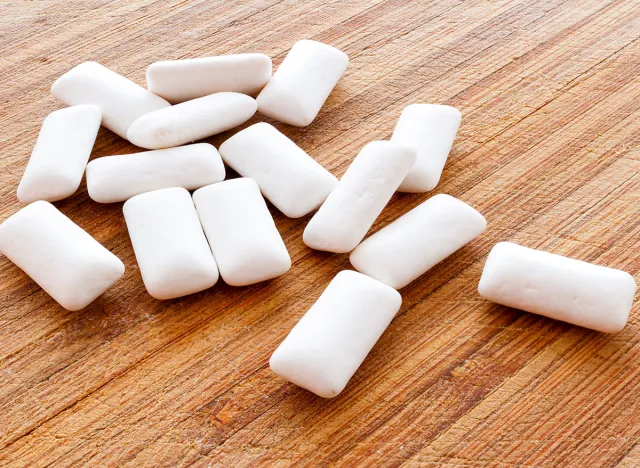10 Nutrition Label Ingredients That Are Major Red Flags for Your Health

When you browse packaged foods at the grocery store, you probably compare nutrition facts to find the best option. Looking for items that meet your calorie needs, support your weight goals, and provide valuable nutrients is a smart way to narrow down the thousands of options on store shelves. However, most people don’t spend much time looking at the ingredient list. This section listed under the nutrition facts gives more insight into a product’s benefits and drawbacks than you may think.
Packaged foods provide convenience, mouth-watering flavors, and valuable nutrients. To achieve these flavors, vibrant colors, and extended shelf life, manufacturers often use questionable ingredients. Minimally processed, whole foods help you avoid many of the additives often found in packaged options. However, when you do reach for packaged foods, it’s important to know which ingredients to watch out for. Here are 10 ingredients commonly found on nutrition labels that should raise a red flag. And for more on what you should be eating, check out these 30 Healthiest Foods To Eat Every Day.
High Fructose Corn Syrup

From soda and juice to canned fruit, cereal, and dairy products, high fructose corn syrup (HFCS) is a common ingredient in packaged foods and drinks. Over the last several decades, HFCS has become a common ingredient as manufacturers look for cheaper ways to sweeten their products. This ingredient is cheaper than sugar, yet provides a similar sweetness, and can aid in the texture and moisture retention in food. However, research suggests HFCS may increase risk of metabolic dysregulation and obesity. Not to mention, HFCS is a source of empty calories that not only contributes to weight, but may also negatively impact dental health.
The American Heart Association advises limiting added sugars, including HFCS, to fewer than 25 grams per day for women and 36 grams per day for men. Reading nutrition labels carefully can help you steer clear of this problematic ingredient.
Sodium Nitrite

You will most often find sodium nitrite in cured meat products, like BBQ meat, deli meat, and jerky. This preservative helps retain the natural color of meat, but it comes with potential health risks. Research suggests that sodium nitrite in processed meats may produce carcinogenic compounds, increasing your risk of cancer.
Luckily, many brands now offer nitrate-free cured meats. Comparing ingredient lists can help you find these healthier options—and a little extra effort can make a big difference in improving the quality of your grocery basket.
Red No. 3

Extensive research has raised concerns about the safety of food dyes, and Red No. 3 is no exception. Manufacturers add these food dyes to foods and drinks to create a more appealing color, especially in kids’ products. Although the bright colors make some options very popular, it may simultaneously harm your health. In one study, rats exposed to Red No. 3 developed a higher incidence of thyroid tumors. Regulators have also banned this dye in cosmetic products due to its potential carcinogenic effects in animals.
With risks like these, avoid Red No. 3 and limit your consumption of food dyes and artificial colorings.
Titanium Dioxide

Although banned from use in food in Europe, titanium dioxide is still found in many popular products in the U.S. This ingredient is commonly used in manufactured foods with a white color, such as coffee creamer, gum, frosting, and pudding.
Research suggests that titanium dioxide may accumulate in the body, leading to potential DNA and chromosomal damage. The FDA has not independently reviewed the safety of titanium dioxide since its approval in the 1960s but is currently evaluating whether to revoke its use in food. Until a decision is made, it’s best to avoid this ingredient when possible.
Tertiary Butylhydroquinone

TBHQ, or tertiary butylhydroquinone, is a common food additive used as a preservative, often alongside other controversial ingredients. The Center for Science in the Public Interest (CSPI) recommends avoiding TBHQ, citing research that linked it to a higher incidence of tumors in rats. This additive frequently appears in snack foods, cereals, and crackers, including many products marketed to children. Despite its widespread use, growing concerns about its potential health risks have put TBHQ under increased scrutiny.
BHA & BHT

Butylated hydroxyanisole (BHA) and butylated hydroxytoluene (BHT) are preservatives commonly used in processed foods like crackers and cereal. These additives help prevent fats in food from becoming rancid. Although the FDA considers BHA and BHT safe within specified limits, animal studies indicate that BHA may increase the risk of cancer in humans. Other research suggests that both BHA and BHT could disrupt sex hormones. Due to these concerns, many manufacturers are turning to vitamin E as a safer and less controversial alternative.
Aspartame

Aspartame, one of the most commonly used artificial sweeteners, is found in soda, energy drinks, gum, and many low-sugar products. While some people report mild side effects like headaches and dizziness, research suggests it may pose more serious risks. Studies have linked aspartame to potential issues such as diabetes, obesity, glucose and insulin intolerance, and changes in gut microbiota.
Over the decades there has been plenty of conflicting research regarding the carcinogenic properties of aspartame, providing enough reason to limit this ingredient.
Potassium Bromate

Potassium bromate is commonly found in flour and prepared bread products. Bakers have traditionally used it to increase bread volume and create a desirable crumb texture. While most bromate quickly breaks down into harmless bromide during baking, bromate itself has been shown to cause cancer in animals. Although the residual bromate in bread presents only a small risk to consumers, its use has been banned in most countries worldwide.
Although many flour millers and food manufacturers have removed potassium bromate from their processes, it’s still important to check ingredient lists and avoid products that contain it. Even small residual amounts pose unnecessary risks.
Acesulfame Potassium

Acesulfame potassium (Ace-K), a zero-calorie sweetener, is commonly found in diet drinks, and low sugar gum and candy. Although you will find contradicting research and opinion on this ingredient, some research indicates it may pose health risks with one study noting Ace-K may affect cognitive function. When the first safety test was conducted on Ace-K in the 1970s, data suggested it could be carcinogenic in rats. However, these tests were thought to be flawed.
To err on the side of caution, it’s wise to limit your intake of products containing this artificial sweetener.
Caramel Coloring

Commonly found in soda, baked goods, and cooked meats, caramel coloring may pose some worrisome health risks. When caramel coloring is produced using ammonia, it can form 4-Methylimidazole, a compound that studies link to lung cancer and leukemia in mice and rats
The amount of caramel coloring one may consume from sauces, like soy sauce and Worcestershire sauce is likely minimal. However, those who drink soda daily are likely consuming a more concerning amount.
- Source: https://www.ncbi.nlm.nih.gov/pmc/articles/PMC5747444/
- Source: https://www.heart.org/en/healthy-living/healthy-eating/eat-smart/sugar/how-much-sugar-is-too-much
- Source: https://pubmed.ncbi.nlm.nih.gov/35303088/
- Source: https://pubmed.ncbi.nlm.nih.gov/2824305/
- Source: https://pmc.ncbi.nlm.nih.gov/articles/PMC10675837/#:~:text=Evidence%20suggests%20TiO2%20NPs,longer%20a%20safe%20food%20additive.
- Source: https://www.cspinet.org/article/tbhq-tert-butylhydroquinone
- Source: https://ntp.niehs.nih.gov/sites/default/files/ntp/roc/content/profiles/butylatedhydroxyanisole.pdf
- Source: https://www.sciencedirect.com/science/article/abs/pii/S0300483X04006079?via%3Dihub
- Source: https://pmc.ncbi.nlm.nih.gov/articles/PMC1567851/
- Source: https://journals.plos.org/plosone/article?id=10.1371/journal.pone.0070257
- Source: https://www.cspinet.org/article/acesulfame-potassium









